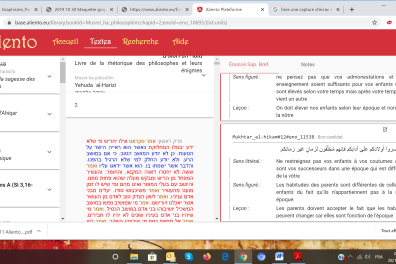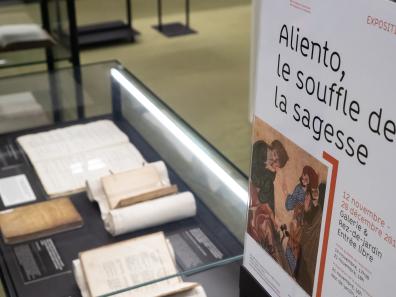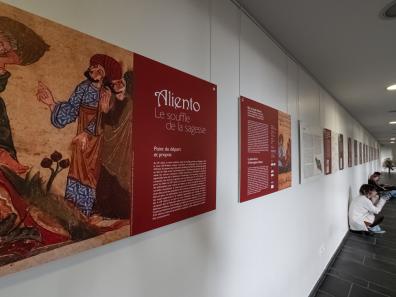The Aliento database

At the beginning of Aliento was the edition of a glossed proverb in Judeo-Spanish written in 1983 for her son by a lady from Bulgaria, Mrs. Flore Gueron Yeschua. In her glosses, the author recounted exempla from various sources whose memory remained linked to the proverb, and made links between proverbs that wove ancient sapiential networks. For example, "The eye of man is only satisfied with a little earth" unknowingly referred to the novel by Alexander the Great, and the proverb quotations she drew up were grouped together in an aljamiado (Spanish in Arabic characters) text from the 15th century, La leyenda de Alexandro, to which she could not have had access.
We delved deeper into this subject with my colleague Marie-Sol Ortola, a specialist in Spanish texts of the Middle Ages and Renaissance, and, back in 2007, we drew up a diachronic project leading from ancient sources to modern Mediterranean and European proverbs, through wisdom texts exchanged and translated in the Iberian Peninsula in the Middle Ages. From our respective studies, four main ideas emerged:
- There was no solution of continuity between the Middle Ages and the Renaissance
- There was no clear cut between orality and writing; there existed between scholarly writings and oral tradition an intermediary sapiential literature intended for the "honest man" of the Middle Ages and which exceeded this circle through public readings.
- Most of the statements contained in these wisdom texts (from the 11th to the 13th c.) were always part, consciously or not, of our shared references.
- The chain of transmission that led from medieval Arabic to European languages was based on a heterogeneous and very ancient fund that could not be summed up in Greek sources translated into Arabic. This diachronic layer included Assyro-Babylonian, Indian, Persian, Aramaic, biblical texts, the Gospels, patristic texts, the Koran...
.

The project thus outlined being too broad, we decided to build a prototype enabling us to compare the Enoncés Sapientiels Brefs (ESB) of these texts, a global denomination grouping together proverbs, sentences, maxims, dits, aphorismes, apophtegmes..., whose definition is "any brief statement (between one word and two or three sentences) presented as a unit containing a lesson, advice, moral, judgment (moral or social)". We delimited a corpus of eight sapiential texts translated from Arabic and disseminated in the Iberian Peninsula from the 10th to the 15th c, in Arabic, Hebrew, Spanish, Latin and Catalan, whose links were relatively well known.
To show how ancient source ESBs circulated between three religious cultures and five languages in this space-time we established an annotation methodology intended to build a tool for cross-referencing these texts in five languages and matching their ESBs (matching algorithm).
Winning an ANR grant in 2013 gave us a working platform and enabled us to launch the operations of cutting and tagging the texts, previously digitized. The Aliento (Analyse linguistique, interculturelle d'énoncés sapientiels et transmission Orient/Occident - Occident/Orient) interrogation platform is the result of collaboration between the Atilf (Étienne Petitjean), MSH Lorraine (Marie-Sol Ortola) and Inalco (Marie-Christine Bornes Varol), which began in January 2014 with support from ANR.
The meaning (literal, figurative), lesson and keywords of around 10,000 ESBs were translated (into French, English and Spanish) by teams of PhD students, post-docs and teacher-researchers. Modeled annotations relating to the form and structure of the ESBs were added so as to align text, lemmatization and syntactic functions, search for syntactic molds, figures of speech, types of discourse...
From the annotations (relating to meaning) Hai Hieu Vu created a matching algorithm that calculates similarities between the ESBs contained in the database. Benjamin Husson from Atilf has built a query platform, accessible from www.aliento.eu , which allows users to search by word, expression... or by ESB, to group similar ESBs in similarity lists and to retrieve all related information whatever the language of the text.
Fourteen digitized sapiential texts and their metadata have been added to the core corpus, some of which are fully or partially tagged (translated and populated). The annotation guide and commented keyword list are available online in the three languages of the database. The work and research generated by the project have given rise to ten issues of the journal Aliento - Echanges sapientiels en Méditerranée.

The Aliento database, in Open Access, establishes an effective descriptive model transferable to other similar corpora, enabling the BSEs of any sapiential text ancient, medieval, modern or contemporary to be compared with those of other texts in the database. It can enlighten text specialists, paremiologists and linguists on textual circulations. It offers IT researchers enriched multilingual texts, opening up the possibility of developing other IT tools. The public can discover the topicality of medieval Arabic texts by searching for proverbs in use today, such as "Ce n'est pas la fonction qui fait l'homme, mais l'homme qui fait la fonction" or "el yerro del médico la tierra se lo traga", and trace their progress.
Marie-Christine Bornes Varol
Director of the CERMOM EA 4091
Inalco rapporteur for Aliento
www.aliento.eu
More information:
Digital humanities and pedagogy projects form axis 5 of Inalco's CERMOM EA 4091.
As such, one of Cermom's PhD students, lecturer at Inalco, Pandelis Mavrogiannis, is working on a major Inalco-supported digital project in which the Cocoon platform and BNF are collaborating: The Judeospanish Oral Archive.
The Cermom / Inalco also hosts the ANR LJTrad project, supported by Arnaud Bikard, on the translation of Jewish languages, which has an important digital component (consultation platform, development of OCR tools for Yiddish, etc.).
Finally, MOOC projects are developed and directed by Luc Deheuvels.
.

La Bulac has made a whole series of photos of the copies it keeps in connection with our project (vitrines ouvrages) and the paintings exhibited in the PLC Gallery for the Aliento, the breath of wisdom exhibition it has organized, in November / December 2019.
Aliento
www.aliento.eu
Marie-Christine Bornes Varol
http://www.inalco.fr/enseignant-chercheur/marie-christine-bornes-varol
Marie-Sol Ortola
https://lis.univ-lorraine.fr/membres/associes/ortola-marie-sol
Etienne Petitjean
https://www.aliento.eu/fr/acteurs/etienne-petitjean/
Hai Hieu Vu
https://www.aliento.eu/fr/2016/09/bienvenue-a-hai-hieu-vu/
Benjamin Husson
http://www.atilf.fr/spip.php?article167
Atlif
http://www.atilf.fr
